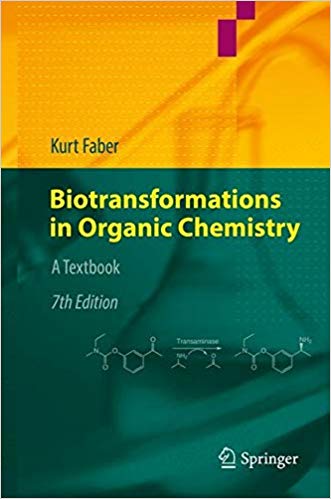Lecture
Organic Chemistry II
Wolfgang Kroutil, Rolf Breinbauer
VO, 2.66 st. (SS)
Content:
Modern organic chemistry will be taught, like the use of metal catalysis (for oxidation & reduction reactions, C-C and C=C bond formation and rearrangements), selective reductions and oxidations, rearrangements, cascade reactions and the usage of ionic liquids. The knowledge about heteroaromatic compounds will be widened. Furthermore protecting group strategies, the production and mechanisms of indicators/organic pigments and the synthesis of petides, DNA and bioactive compounds will be discussed. In a separate chapter the basics for ‘green’ chemistry will be discussed.
- Basics
- Synthetic methods
Carbon-carbon bond formation
Reduction
Oxidation
Substitution
Elucidation of reaction mechanisms
- Synthetic techniques
Planning of syntheses
Protective groups
Synthesis of biopolymers
- Green chemistry
Recommended Textbooks:
- P. Y. Bruice, Organic Chemistry 4th ed., Pearson Education, Inc., 2004, ISBN 0-13-121730-5.
- J. Clayden, N. Greeves, S. Warren, P. Wothers, Organic Chemistry, Oxford University Press, 2000, ISBN 0-19-850346-6.
- E. Breitmaier, G. Jung, Organische Chemie II, G. Thieme Verlag, Stuttgart-New York, 1983, ISBN 3-13-541601-1.
- J. March, Advanced Organic Chemistry, Wiley, 1992, ISBN 0-471-60180-2.
UNIGRAZonline: CHE.896
Lecture
Asymmetrische Synthese
Mélanie Hall
VO, 2 st. (WS)
Content:
After a repetition of the basics of stereochemistry, different methods of synthesising chiral molecules will be discussed. Five principles of asymmetric synthesis will show the development of the field over the past few decades. Special emphasis will be laid on methods that use a chiral reagent or chiral catalyst, e.g., chiral borohydrides, Sharpless epoxidation, Jacobsen epoxidation, Sharpless dihydroxylation, etc. In addition to the organocatalytic and metallocatalytic methods also biocatalytic options will be discussed.
- Introduction: Chirality
- Biological significance of chirality
- Analytical methods
- Asymmetric synthesis
strategies for asymmetric synthesis
kinetic & thermodynamic considerations
non-linear effects, asymmetric autocatalysis
1st generation & chiral pool
2nd generation – chiral auxiliary
3rd generation – chiral complexation
4th generation – chiral reagents
5th generation – asymmetric catalysis
Recommended Textbooks:
- R. A. Aitken, S. N. Kilenyi (eds.), Asymmetric Synthesis, Blackie, London, 1995.
- I. Ojima (ed.), Catalytic Asymmetric Synthesis, Wiley-VCH, New York, 2000.
- D. J. Ager (ed.), Handbook of Chiral Chemicals, Marcel Dekker, New York, 1999.
UNIGRAZonline: CHE.345
Biotransformations in Organic Chemistry – A Textbook

This well-established textbook on biocatalysis provides a basis for undergraduate and graduate courses in modern organic chemistry, as well as a condensed introduction into this field. After a basic introduction into the use of biocatalysts—principles of stereoselective transformations, enzyme properties and kinetics—the different types of reactions are explained according to the 'reaction principle', such as hydrolysis, reduction, oxidation, C–C bond formation, etc. Special techniques, such as the use of enzymes in organic solvents, immobilization techniques, artificial enzymes and the design of cascade-reactions are treated in a separate section. A final chapter deals with the basic rules for the safe and practical handling of biocatalysts.
The use of biocatalysts, employed either as isolated enzymes or whole microbial cells, offers a remarkable arsenal of highly selective transformations for state-of-the-art synthetic organic chemistry. Over the last two decades, this methodology has become an indispensable tool for asymmetric synthesis, not only at the academic level, but also on an industrial scale.
In this 7th edition new topics have been introduced which include alcohol and amine oxidases, amine dehydrogenases, imine reductases, haloalkane dehalogenases, ATP-independent phosphorylation, Michael-additions and cascade reactions. This new edition also emphasizes the use of enzymes in industrial biotransformations with practical examples.
Further information: springer.com
When the COVID pandemic restricted us to the home office in 2020, we decided to start a series of online seminars called "Who Is Who Enzymes", in which one of our researchers summarises the history, enzymology and applications of an enzyme class in a 20–30 min presentation. Now we're back in the lab, but "Who Is Who of Enzymes" continues, and we've made it available to everyone as a YouTube video series. Learn the basics about one class of enzymes at a time and check back for new episodes!
We bear no responsibility for the content of external pages. Links to external pages are inicated with the symbol  .
.



 .
.